Need Help with Data Migration to Salesforce?
We provide comprehensive consulting services to address your data management challenges: from auditing data sources to guidance on data migration strategies
In the current era of digital transformation, efficient data migration is crucial, especially as cloud adoption accelerates.
According to Foundry’s research, 63% of IT leaders have ramped up cloud migrations; however, 90% face challenges, primarily due to budget-related issues.
Consequently, this underscores the need for careful planning and strategic execution.
Focusing specifically on Salesforce, this blog outlines why proper data migration to Salesforce is vital and provides a nine-step plan to ensure success.
Also, we explore solutions for data preparation and highlight the top five Salesforce data migration tools, thereby transforming these challenges into opportunities for growth.
In 2010, I purchased my first smartphone and faced the challenge of transferring data from my antiquated old phone.
My contacts were particularly important, but the lack of data transfer functionality on my old device left me in a bind. Unwilling to manually re-enter all the data, I embarked on a quest for a solution.
After several days of extensive research, I stumbled upon an article that detailed a method to extract data from my old phone into a CSV file. To my relief, the process worked seamlessly. I then converted the CSV file into a vCard format and successfully transferred the data to my new smartphone.
This experience underscored the critical importance of data migration, not just for businesses but also for general use.
Overall, a data migration plan is essential for organizations seeking to modernize and enhance their IT infrastructure. It enables seamless data migration from legacy systems to more advanced platforms like Salesforce, thereby improving efficiency, scalability, and accessibility.
This process supports business growth by optimizing data management, reducing costs associated with outdated systems, and facilitating better decision-making through improved data analytics.
Furthermore, effective data migration ensures data integrity and security while aligning IT capabilities with evolving business needs, ultimately fostering innovation and maintaining a competitive edge in a rapidly changing technological landscape.
Learn how we helped Cresa migrate over 8,000 records with 100% accuracy to Salesforce
Whether you are an existing Salesforce user or contemplating the adoption of the platform, one common question arises: “How do I migrate my data to Salesforce from another solution?“.
Salesforce data migration involves transferring information from external systems, such as local databases or legacy CRM platforms, into the Salesforce environment.
This essential Salesforce data migration process not only safeguards data integrity but also enables informed decision-making, enhances customer service, and promotes organizational growth.
Well-planned Salesforce data migration strategy is crucial for maximizing the benefits of Salesforce and ensuring a seamless transition to its robust capabilities.
Preparing for a Salesforce data migration? This nine-step guide offers key strategies for a smooth transition.

9 Steps for a Successful Salesforce Data Migration | Ascendix
Explore essential Salesforce data migration steps, from data backup and cleansing to selecting appropriate tools and performing post-migration validation. Get started to streamline your data migration process.
Data backup involves creating a copy of existing data to prevent loss during migration. It’s crucial for the Salesforce data migration process to ensure that, in case of errors or data corruption, you can restore original data and maintain business continuity.
ALWAYS make a backup before performing any form of data migration. This ensures that even if something goes drastically wrong, the original data remains intact and can be restored. This means that the business will continue to run as smoothly as possible, even in the worst-case scenario.
When planning a data migration to Salesforce, it’s essential to clearly define your objectives. Are you aiming to create new records, update existing data, or both? Start by identifying the specific data types—such as Accounts, Contacts, Properties, and custom objects—that need to be migrated.
Additionally, assess whether any new custom objects need to be created to accommodate unique business requirements. Clearly defined goals ensure a focused and successful migration process.
A comprehensive audit of your current data is an essential step in the Salesforce data migration process. Evaluate its quality and structure to identify any unnecessary or outdated information.
This assessment will help pinpoint duplicates, inconsistencies, and data gaps, and addressing these issues upfront ensures a smoother, more efficient migration.
Choosing the right tools is essential for a successful data migration to Salesforce. For smaller migrations involving up to 50,000 records per object, I’d recommend the Data Import Wizard due to its simplicity, ease of use, and user-friendly interface.
For medium to large migrations, the Data Loader is highly recommended. While not as visually appealing as the Data Import Wizard, it is more powerful and capable of processing up to 5,000,000 records per object.
If you have specific requirements that go beyond the capabilities of both the Data Import Wizard and Data Loader, consider utilizing third-party ETL tools. For instance, the SSIS Integration Toolkit by KingswaySoft offers advanced functionality to accommodate complex migration needs.
In this step you need to map source fields to their corresponding fields in Salesforce, serving as a blueprint for the migration process.
If gaps exist, consider creating new fields in Salesforce to meet your specific needs.
Additionally, define necessary conversions—such as date formats, currency transformations, and picklist values—to ensure seamless data integration and maintain data accuracy.
Before migrating to Salesforce, thorough data cleansing is necessary. This involves removing duplicates and correcting any errors to ensure data integrity. When exporting data from the old system, verify its accuracy and consistency.
Normalize data formats to align with Salesforce requirements, and diligently check the connections between objects.
Learn More: How to Activate Duplicate Rules in Salesforce
A frequently overlooked yet critical step in the migration process is conducting a test migration. This phase allows you to identify and address unforeseen issues that may have been missed in earlier stages.
By executing a test migration with a smaller subset of data, you can ensure a smoother transition.
Carefully verify the integrity of the migrated data within Salesforce to confirm its accuracy and reliability before proceeding to full-scale implementation.
To minimize disruption, schedule migrations during weekends or off-peak hours. Transparently communicate these schedules to all stakeholders.
After completing a successful test migration and resolving any errors, proceed with the actual data migration methodically.
Patience is key—as rushing can compromise results. Continuously monitor the migration process for any issues to ensure a seamless transition.
After completing the migration, verify that all data has been accurately transferred and is functioning as intended within Salesforce.
Utilize Salesforce’s reporting features to thoroughly check the consistency of migrated data against the original dataset.
Pay special attention to the volume of data, relationships between objects, and other critical aspects to ensure everything aligns perfectly, maintaining data integrity and functionality.
We provide comprehensive consulting services to address your data management challenges: from auditing data sources to guidance on data migration strategies
Let’s explore the process of migrating data to Salesforce using Data Loader with a practical approach.
To demonstrate, I’ve prepared a small test case: migrating a list of companies within my organization.

A List Of Companies for Data Migration to Salesforce | Ascendix
Step #1: Open Data Loader, a robust tool for managing data in Salesforce. Our focus will be on the ‘Insert‘ function, which allows us to create new records efficiently.
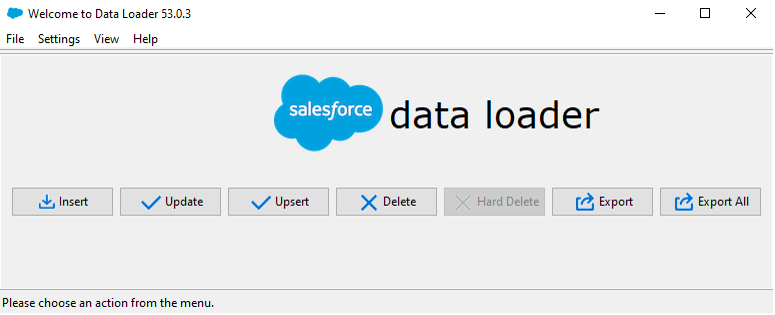
Data Loader for Salesforce | Ascendix
Step #2: In the next window, you’ll be prompted to log in to Salesforce. Click ‘Log in‘ and complete the authorization process.

How to Log Into Data Loader | Ascendix
Step #3: You’ll see a list of all available objects in your organization. Since we are interested in Accounts, select that option.
Step #4: Choose the CSV file you prepared for migration.
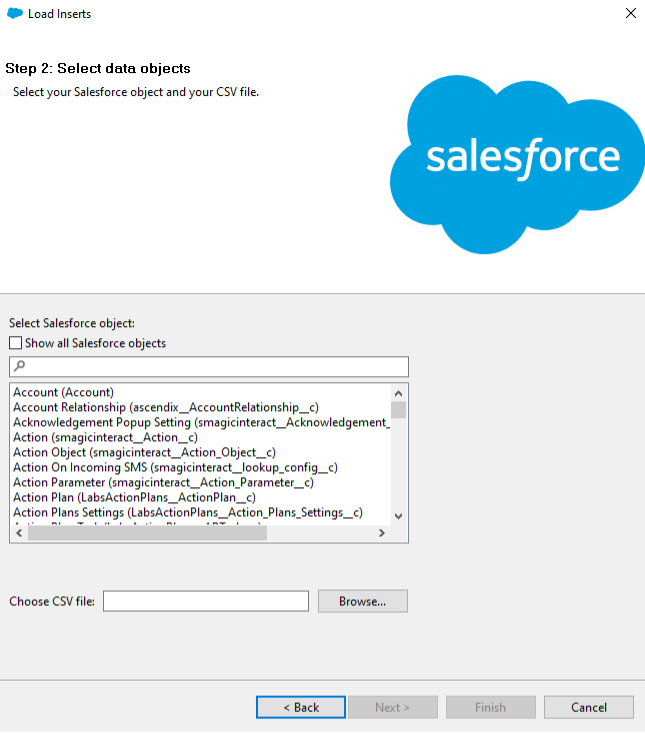
How to Select Data Objects for Migration to Salesforce | Ascendix
File validation is underway. If no primary errors are detected, a confirmation message will appear. Let’s proceed to the next step.
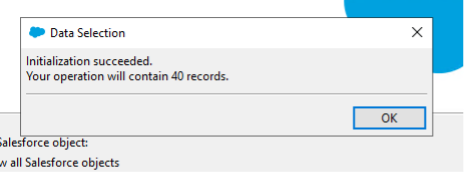
Data Migration Initialization Message | Ascendix
Step #5: Mapping the columns from your file to the corresponding columns in Salesforce. Select ‘Create or Edit a Map’ to begin this process.

Data Mapping to Salesforce Objects | Ascendix
Here, you’ll see a list of all available fields in your organization. If the field names in your file match those in Salesforce, you can use the ‘Auto-Match Fields to Columns‘ feature.
However, if the column names differ—as in my case—you’ll need to manually drag and drop fields from the top table to the corresponding columns in the bottom table.
Once you have completed the mapping, click ‘OK.’
Additionally, you can save this mapping for future migrations by clicking the ‘Save Mapping‘ button. This will allow you to reuse the mapping file, streamlining your next data migration process.
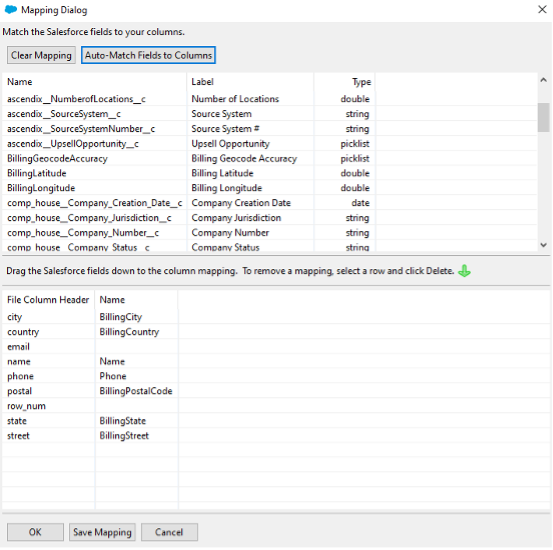
Mapping Dialog Window In Salesforce Data Loader | Ascendix
Step #6: After mapping the fields, click ‘Next’.
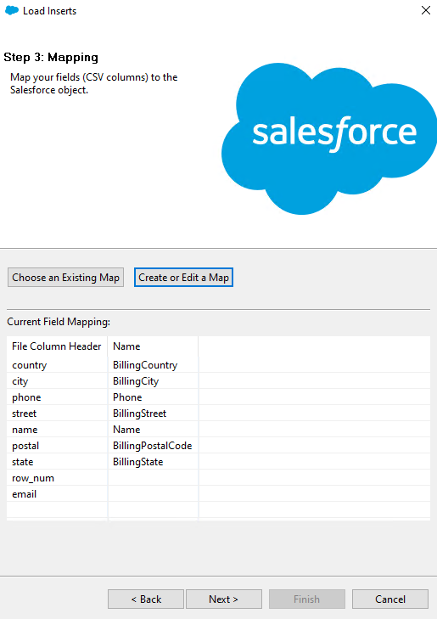
Field Mapping Scheme | Ascendix
Step 7: Select the folder where both successful and error logs will be saved.
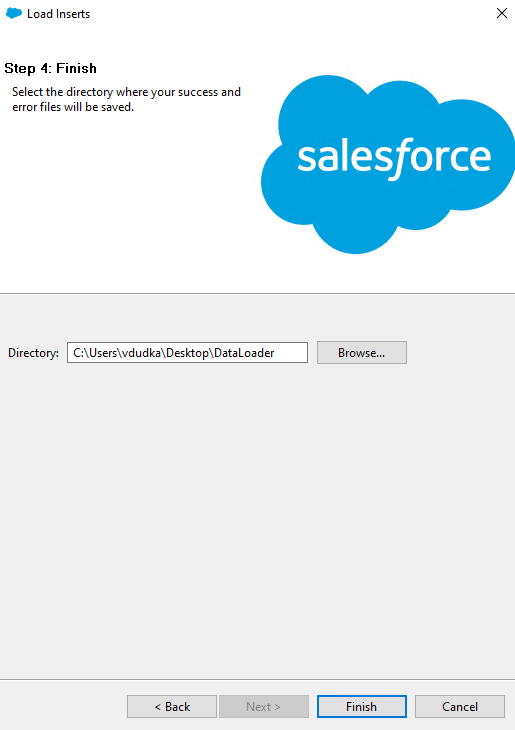
Select the Folder Where Successful and Error Logs Will Be Saved | Ascendix
Step #8: Once set, click ‘Finish‘ to complete the process.
A final prompt will ask you to confirm whether you’re sure you want to proceed with this operation.

Confirmation Window You Want to Proceed with Data Migration | Ascendix
The data migration is complete. Noticed an issue? While 39 records were successfully created, 1 error occurred. Let’s review it.

Error Message Window | Ascendix
Step #1: Navigate to the folder where you chose to save the migration logs.

Data Migration Logs | Ascendix
Step #2: Examine the successful log. Everything appears to be in order. This log is essentially the same file you prepared for migration but with two additional columns.
The first new column is ‘ID‘, which provides the system-generated ID of the created record—useful for linking objects in the future if necessary.
The second column is ‘Status‘, indicating whether the record was successfully created.

The File with Data Migration Logs | Ascendix
Step #3: Examine the second file, the error log. Like the successful log, it mirrors the entries from your source file.
However, it includes an additional ‘Error‘ column that specifies what went wrong.
In this instance, the error log reveals that one record wasn’t created due to an invalid phone number entry.

A Detected Error During The Data Migration to Salesforce | Ascendix
Reach out for a customized migration plan that minimizes downtime and maximizes your operational efficiency.
| - Intuitive graphical interface - Supports import into standard and custom objects - Pre-import error checking | Users with small to medium data import needs without technical expertise | Limited to small to medium record volumes | |
| | - Handles large data volumes - Supports all custom objects - Generates CSV logs for auditing | Administrators and developers managing bulk data operations | Requires technical understanding for effective use |
| | - Supports insert, update, upsert, query, delete, and bulk load - Works with various data sources and formats - Intuitive UI for data mapping | Short ad-hoc tasks and client/lead data inputs | Requires understanding of API integration |
| - Intuitive interface with Vlookup support - Import, export, delete, and schedule jobs - Auto-mapping and audit history tracking | Dynamic environments such as health and education sectors | No volume restrictions, may overload administrators | |
| - Integrates diverse data sources - Processes large data volumes - User-friendly interface | Complex data integration tasks across systems | May require significant customization effort |
Salesforce Data Import Wizard is a built-in tool designed to streamline the data import process within Salesforce.
Its intuitive graphical interface makes it accessible to users without technical expertise, facilitating a smooth import experience.

Salesforce Data Import Wizard Interface
Key Features:
Salesforce Data Import Wizard is an effective solution for users seeking to manage data imports efficiently without extensive technical knowledge.
Salesforce Data Loader is a robust tool designed to facilitate data management within Salesforce, particularly benefiting administrators and developers engaged in bulk data operations.

Salesforce Data Loader Interface
Key Features:
Overall, Salesforce Data Loader is an essential tool for professionals looking to perform detailed and large-scale data operations within Salesforce.
JitterBit Data Loader integrates AI, integration, and API capabilities to enhance data migration processes.
Its intuitive design and versatile functions make it highly suitable for inputting data on prospective clients or leads, especially for short ad-hoc tasks.
The user-friendly API development technology further allows for the reuse of applications and data.
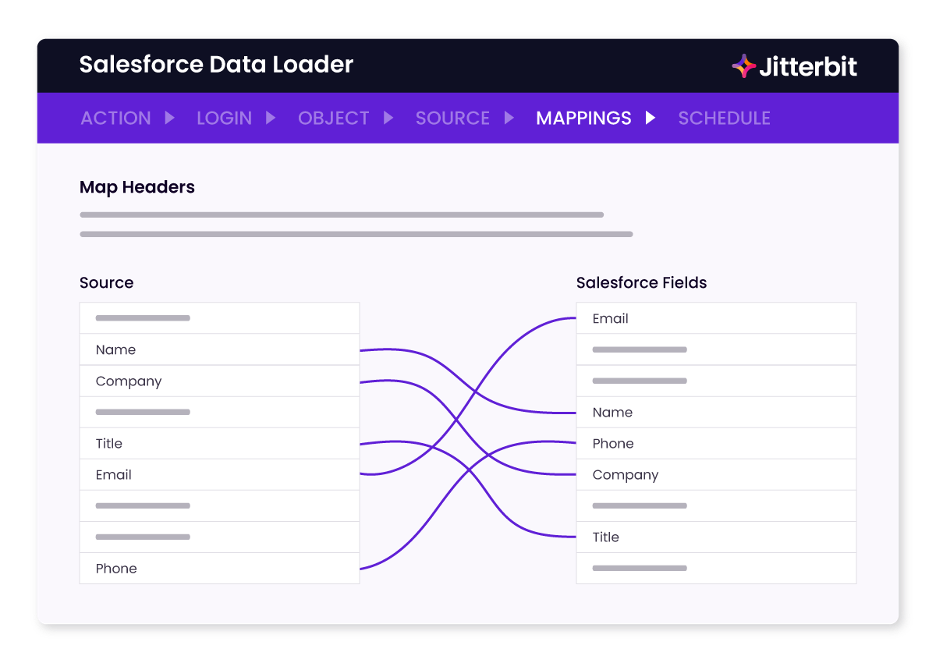
Jetterbit Interface | Source: AppExchange
Key Features:
JitterBit Data Loader is designed to streamline data migration tasks efficiently and effectively, accommodating a wide range of data handling needs with its comprehensive features.
Dataloader.io, developed by MuleSoft, is a cloud-based tool designed to facilitate data management tasks through a simple and intuitive user interface.
Dataloader.io is commonly used in sectors such as health and education, where data is frequently updated, emphasizing its reliability in dynamic environments.
It has three versions of pricing plans: free and two paid ones, catering to different user needs and budgetary constraints.
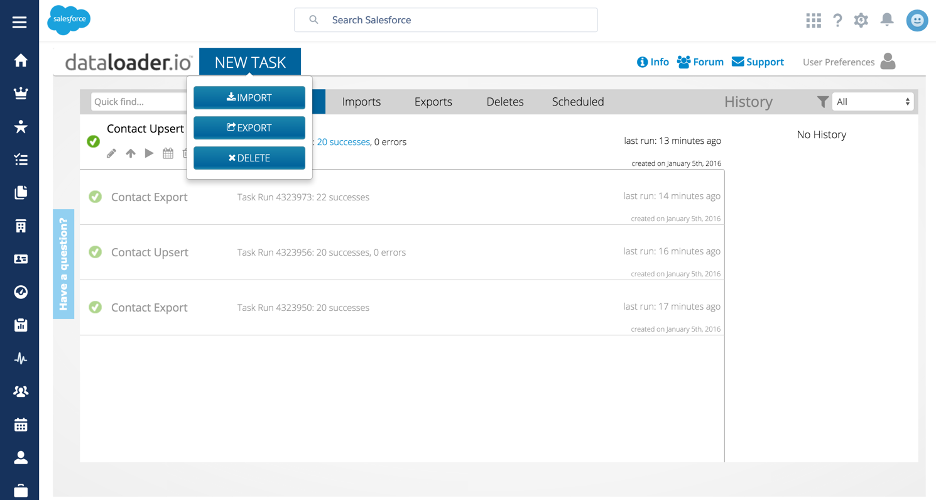
Dataloader.io Interface | Source: AppExchange
Key Features:
Dataloader.io is a versatile tool tailored for efficient data management in cloud environments, offering robust features that support various operational and sector-specific needs.
The SSIS Integration Toolkit from KingswaySoft is an extension designed for Microsoft SQL Server Integration Services (SSIS), offering enhanced integration capabilities with a variety of data sources.
It supports seamless data migration and integration across CRM systems, ERP solutions, cloud services, and other applications.
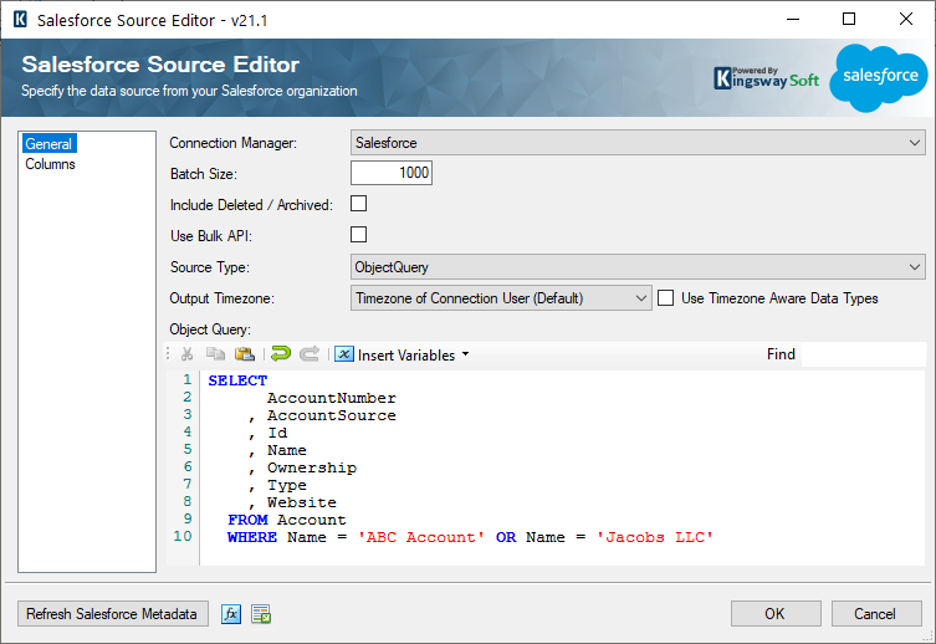
SSIS Integration Toolkit by KingswaySoft Interface | Source: AppExchange
Key Features:
The SSIS Integration Toolkit by KingswaySoft is a robust Salesforce data migration tool for organizations seeking to enhance their data integration processes, offering powerful features tailored for comprehensive data management across various systems.
Steering through the complexities of data migration —from detailed business analysis and careful data transfer to precise system configurations—demands expertise and precision.
By leveraging our extensive Salesforce consulting experience, you can unlock substantial and long-lasting benefits.
At Ascendix, a leading Salesforce Crest Consulting and Microsoft Partner based in Dallas, Texas, we offer unmatched proficiency in Salesforce data migration services.
With over two decades of experience, our team has successfully managed over ten CRM systems, expertly transitioning data from Excel spreadsheets, platforms like Dynamics 365, or migrating data from legacy systems to Salesforce or AscendixRE, our Salesforce-based CRM tailored for commercial real estate professionals.
Our dedicated team of over 70 certified Salesforce specialists conducts a thorough assessment of your current CRM system to facilitate a seamless transition to the Salesforce platform, ensuring that your data and workflows are optimized for enhanced business efficiency and performance.
As your Salesforce data migration consultant, we’ll:
Our professionals will ensure your Salesforce migration flows seamlessly, keeping your project aligned and on target every step of the way. Need help with complex data migration to Salesforce? Book a free Salesforce consulting call.
Data migration in Salesforce involves transferring data from legacy systems, other CRM software or third-party solutions to the Salesforce platform. This process includes extracting, transforming, and loading data, ensuring that all records are accurately moved while maintaining data integrity, consistency, and alignment with business objectives.
The recommended order for data migration in Salesforce typically begins with foundational data like Accounts and Contacts, followed by related data such as Opportunities and Cases. Subsequent steps include custom objects and child records, ensuring dependencies and relationships are preserved and accurate throughout the process.
The duration of Salesforce data migration varies based on data volume, complexity, and quality. Small to medium migrations may take a few weeks, while larger, more complex projects can span several months. Proper planning and testing are crucial to ensuring a smooth and efficient migration process.
Vitalii is a Software Developer at Ascendix Technologies with over 5 years of experience specializing in data analysis, development and testing of ETL processes. He is a specialist in data migration and helps businesses streamline their data integration and management efforts.